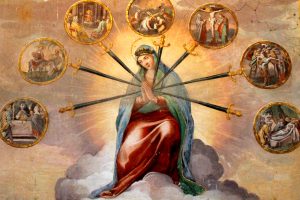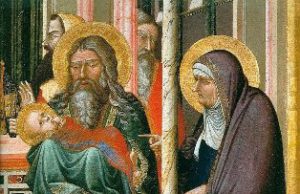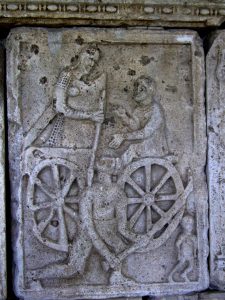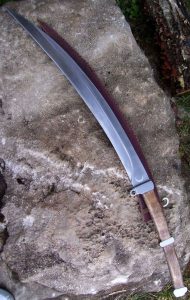 Sunday, 15 September is, in the traditional calendar, the Feast of Our Lady of Sorrows (2nd Class). For Holy Mass we will use the 14th Sunday after Pentecost with commemorations of the Feast.
Sunday, 15 September is, in the traditional calendar, the Feast of Our Lady of Sorrows (2nd Class). For Holy Mass we will use the 14th Sunday after Pentecost with commemorations of the Feast.
I believe that the Rubricae Generales of the 1962 Missale Romanum (342 & 370-372) allow a diocesan bishop to permit the celebration of the Feast on the Sunday (2nd Class). This mystery is also observed liturgically during the 5th week of Lent in the traditional calendar. And, of course, Good Friday has also called forth devotional practices such as processions with statues of the Mater Dolorosa. How could it not?
In the 12th c. German Benedictines began to develop the devotion of Our Lady in her moments of sorrow. In the 13th c, the Servite Order, founded near Florence, made the sorrows of Mary a central dimension of their devotion. They developed, among other things, a kind of rosary and a Black Scapular dedicated to Our Lady’s sorrows. Over the centuries Mary has been depicted not just as the Mother holding her dead Son, Pietà, but also as having seven swords, one for each moment of sorrow attested in Scripture and tradition, piercing her breast. Alternatively, you see her surrounded with images of those moments.
The Seven Sorrows
The prophecy of Simeon. (Luke 2:34–35)
The flight into Egypt. (Matthew 2:13-23)
The loss of the Child Jesus in Jerusalem. (Luke 2:43–45)
Mary meets Jesus on the way to Calvary. (Tradition)
The Crucifixion of Jesus. (Matthew 27:34–50, Mark 15:23–37, Luke 23:33–46, John 19:18–30)
The Piercing of the Side of Jesus, and His Deposition. (John 19:34)
The Burial of Jesus by Joseph of Arimathea. (Matthew 27:57–61, Mark 15:43–47, Luke 23:50–53, John 19:40–42)
Shall we, in the next few days, look as some aspects of the Seven Sorrows? Here are a few ideas to consider. And before any of you enthusiastically write, as inevitably some do, “You forgot… X!” No. I didn’t. I offer here some ideas, not all possible thoughts. Many great writers have contemplated Mary. Each of these mysteries is a bottomless serving of rich fare, like baskets and fish that keep on feeding.
The Prophecy of Simeon. (Luke 2:34–35)
And Simeon blessed them and said to Mary his mother, “Behold, this child is set for the fall and rising of many in Israel, and for a sign that is spoken against (and a sword will pierce through your own soul also), that thoughts out of many hearts may be revealed.”
It is usual for Catholics to say an Our Father and seven Hail Marys for each of the Sorrows of Mary. You might do that now.
Context: The Lord comes to the Temple for the 1st time. Ultimately, His Body is the New Temple, to be established in the heavenly Jerusalem. Now He comes to the earthly Temple, already High Priest, already perfect Victim, ready to shed His Precious Blood for the first time for His mission of propitiation and to teach us who we are, to reveal man more fully to himself (GS 22).

Here are Anna, the prophetess, whose Feast was 1 September. Even in our calendar, she is close to the Temple where she, a widow, waited for 80 years for the true Bridegroom. Here is elderly Simeon, probably a priest, whose 8 October feast, with Anna’s, brackets the first of the sorrows of Mary, the presentation of the Christ Child for His Circumcision.
Simeon takes the Child into his arms and raises in that moment a song of joy which we sing every evening at Compline, the Nunc Dimittis. Surely it is a paen of joy, but with a profundity that expresses itself not in enthusiasm, but expresses also the weariness of a labor completed, like that of the satisfaction of a hard day’s, life’s, task. Many composers through the centuries have set the Nunc Dimittis, so important in the Roman Rite, to music. The settings, whether of Josquin des Prez, or Palestrina, or Holst, Rachmaninov, or Dyson, or Pärt, are restrained and introspective, calm as befitting a sense of completion of a life lived in uprightness and in hope.
Here is Palestrina’s version, sung by the Tallis Scholars in St Mary Major in Rome in 1994. I was present at this concert.
Haunting Pärt.
Simeon’s joy is weighted with gravity.
Mary’s pattern, in Scripture, is to be still and take all things in before she ponders and then speaks. As I picture the moment, she watches and listens. She is utterly still, taking it all in. Simeon holds Jesus as he pronounces his Nunc Dimittis. Then he turns to look at her. Still guided by the Holy Spirit, the old priest prophesies – for her benefit – about “the fall and rising of many”, and that Christ is a “sign of contradiction”, literally “spoken against”, and that “a sword” would pierce Mary’s soul so that “thoughts out of many hearts be revealed”.
What mother wouldn’t halt in her tracks at this description of her and her Child’s destiny?
Consider that Mary hears with ears perfectly tuned to what God says to her in Scripture, in the human voice, in the sounds of nature. She knows the Scriptures. She knows of the Suffering Servant. She knows about Eve.
 The word for “sword” here in Greek is rhomphaia which can be a large sword but is more accurately a curved blade on a short staff, slung on the back, used in close combat by Thracians.
The word for “sword” here in Greek is rhomphaia which can be a large sword but is more accurately a curved blade on a short staff, slung on the back, used in close combat by Thracians.
Ancient reliefs show it to be almost like a Japanese odachi, though the odachi is a bit long. Interestingly, the odachi eventually was not used for battle, but became an exceptional temple offering. In any event, Luke uses the odd rhomphaia rather than machaira, the shorter sword of Luke 22:36, which the Lord at the end of the Last Supper instructs His apostles to obtain, the sword which the Lord said he came to bring (Matthew 10:34), and with which Peter cut the ear of the servant of the High Priest (Matthew 26:52). The machaira is the sharp two-edged sword Paul references when describing the word of God (Heb 4:12).
No, in the Temple Simeon mentions the terrible, large curved slashing, thrusting weapon of a notably savage tribe, the rhomphaia. This is the sword of awesome images in the book of Revelation, the “son of man” “the Alpha and Omega” in ch. 1 from whose mouth came a sharp rhomphaia, at whose feet John fell. This is the rhomphaia of the rider of the pale horse, Death in Rev 6, with power to slay a fourth of all living things. This is the sword of the rider of the white horse, Faithful and True, whose robe was dipped in blood, the Word of God, followed by the hosts of heaven (Rev 19).
 To pierce with the rhomphaia, you would need to raise your arms high to thrust downward or, more horribly, keep them low to thrust upward, under the ribs, where the Lord was physically conceived, and into the heart, where He was spiritually conceived.
To pierce with the rhomphaia, you would need to raise your arms high to thrust downward or, more horribly, keep them low to thrust upward, under the ribs, where the Lord was physically conceived, and into the heart, where He was spiritually conceived.
How terrible will be the sorrows that pierce the “soul”, the “psyche”, the seat of feelings and desires, “the heart” of Mary?
Think rhomphaia.
In obedience to the Law, Mary and Joseph have brought their Child to the Temple. St Jerome, who spent much time in Jerusalem, opines that the Child who opened the closed door of the Virgin, now comes as High Priest to open the closed East Door of the Temple, through which only the High Priest can pass. (Adv. Pelag. 2.4)
Already there is a priestly coming with sacrifice toward the East, and then a return, having fulfilled the sacrifice from the East.
Christ has come to be the New Adam and Mary is the counterpoint to the Old Eve, hence the image of the sword brings to mind also the expulsion of Adam and Eve from paradise by the angel with the sword at the garden gates. Remember that Eden was a mountain, and mountains are where altars were built, sacrifices took place for the creation of covenants with God. They are now at the Temple in Jerusalem. Is the piercing of Mary’s heart the conclusive sheathing of the sword of Eden?
Cutting to the quick, the Word pierces her. Eden is no longer needed, for greater than Adam and greater than Eve are now here in the fullness of time.
Simeon says that a rhomphaia will pierce Mary’s heart, which surely refers to the Crucifixion. Is it hard to imagine that Mary will begin to prepare for the Passion of her Son from this point in her life onward? She would have known about the preparation of the lambs at the Pasch, their cruciform stretching on crosses for roasting.
The core Apostles, Peter, John and James, needed their Transfiguration moment with Jesus to prepare for His Passion. Is this the moment, the Presentation in the Temple and Simeon’s solemn prophesies, that guides Mary to prepare for the next 33 years for her sharing in the Passion? In her Magnificat, she rightly proclaimed in joy that her Son would scatter the proud and bring down the mighty. In Simeon’s pronouncement, Christ will be the fall and rising of many, but his message is less of joy than one of warning.
Imagine the rush of thoughts and images which flood Mary’s soul as she stands in the Temple, as Simeon concludes. What follows, the first shedding of the Precious Blood.
Piercing. Cutting. Obedience. Self oblation.
Mary’s sorrow is that of a Mother with a bond more intimate than any mother with her child. Mary’s sorrow is at the same time shot through with pure exalting joy because she relies entirely on God and knows that this is it. This is the time and the “hour” is fast approaching. Sorrowful joy. Joyful sorrow.
Mary will now ponder, for ponder Mary does, in an ongoing, inexorable piercing of her heart over the next 33 years of anticipation of the 3 days of magnificent saving horror.
The Collect for the Feast of the Sorrows of Mary
V. The Lord be with you.
R. And with thy spirit.
Let us pray.
O God, in Whose Passion the sword, according to the prophecy of blessed Simeon, pierced through the soul of Mary, the glorious Virgin and Mother, mercifully grant that we, who reverently commemorate her piercing through and her suffering, may, by the interceding glorious merits of all the saints faithfully standing by the Cross, obtain the abundant fruit of Your passion.
Who livest and reignest with God the Father, in the unity of the Holy Spirit, one God, world without end.
R. Amen

































“Each of these mysteries is a bottomless serving of rich fare, like baskets and fish that keep on feeding.” Thank you for this, Fr. Z! I’ve often thought of Revelation in terms of an onion with its many layers, but this is by far better since the human mind could no more come to the end of the knowledge of God than He would have let the basket be emptied as long as anyone desired or needed more.
Love this feast and love this discussion on Mary’s sorrows.
Thank you for this beautiful meditation and exposition of the first sorrow of Mary.
Pingback: Our Lady of Sorrows Project: 2nd Sorrow – The Flight into Egypt | Fr. Z's Blog
This is wonderful, Father. Thank you. I’m going to save these meditations, they are profound and scholarly. (The “rhomphaia”… wow, I never knew!)
There are also, according to St. Bridget of Sweden, seven graces to be bestowed on those who meditate daily on the Seven Sorrows:
http://m.ncregister.com/blog/joseph-pronechen/our-ladys-seven-sorrows-seven-promises-and-fatimas-connection
There is also a parallel devotion to the Seven Joys of Mary
https://aleteia.org/2017/08/27/do-you-know-the-7-joys-of-the-blessed-virgin-mary/amp/
This was a popular Medieval theme for carols
https://www.hymnsandcarolsofchristmas.com/Hymns_and_Carols/seven_joys_of_mary.htm
I began praying the Servite Rosary several years ago. I found an old, simple Servite Rosary and just started doing it. God has really blessed me through the mediation of the seven sorrows. It changed the way I see my own suffering, primarily by allowing God to bless my life through the big and small contradictions that I experience every day. Praying this rosary has given me an attitude of Godly gratitude that I didn’t have before. I highly recommend it.
Thank you for teaching us about this powerful devotion!
Pingback: Our Lady of Sorrows Project: 3rd Sorrow – The loss of the Child Jesus in Jerusalem | Fr. Z's Blog
Pingback: Our Lady of Sorrows Project: 4th Sorrow – Mary meets Jesus on the way to Calvary | Fr. Z's Blog
Thank you very much for this series, Fr Z.
I began yesterday and will try to catch up.
Just to nitpick, the Baby Jesus would already have been circumcised, on the 8th day, by the time he was presented in the Temple.
(I’ll slink away now.)